CLEAN UP WITH GAS
Page 23

If you've noticed an error in this article please click here to report it so we can fix it.
LESS SMOKE, NOISE AND SMELL WITH LPG CONVERSION FROM PERKINS
by Trevor Longcroft FREEDOM from smoke and reduced engine noise and exhaust emissions are claimed for , the Perkins 6.354 diesel engine converted by Yorkshire Autoga s Ltd, S haysyke, Halifax, to a spark ignition unit run on LPG.
A prototype engine has already been fitted to a gulley emptier based on the Dodge K850 municipal chassis with bodywork by Yorkshire Vehicles; it was on show at Scarborough this week. The vehicle was ordered by Norwich City Council.
No emission figures are available for the prototype engine but the company expects a 25 per cent reduction of NOx and hydrocarbon constituents when measured on a gram per brake horsepower basis. The COx level is not expected to change.
Yorkshire Autogas claims that the fuel cost per mile between the two engines is comparable; the Dodge has a high liquid gas consumption 2.11cm/ 1 (6mpg) but this is offset by its low cost — 26p to 30p per gallon.
Apart from its social advantages LPG also offers easier maintenance. Complete combustion virtually eliminates contamination of the engine lubricating oil and it is claimed that oil-change periods as much as three times longer than that of a diesel engine can be achieved. Cylinder bore wear is reduced by as much as 75 per cent and spark plug life is expected to be 40,000km (25,000 miles).
To convert the prototype engine, the company altered the shape of the combustion chamber and reduced the compression ratio from 16 to 8:1 -later models will have a 9.5 to 1 compression ratio, initially to improve consumption though a power bonus is also expected.
The vertically mounted DPA fuel injection pump is replaced by a conventional distributor and the injector sleeves are modified to accept standard spark plugs. A gas carburetter is placed on the inlet manifold and gas is fed to the carburetter from an evaporator.
The prototype engine is rated to 171.6kW (230 bhp) gross at 2,800 tpm an 8 per cent improvement over the diesel version. Torque output remains at about 305Nm (2,251 bft) at rated engine speed but rises to about 447Nm (3,301 bit) at 1,000 rpm. This represents an improvement of almost 25 per cent over the diesel at that speed and the rising torque should provide useful "staying power" in individual ratios, say when pulling up a gradient.
The conversion costs about £400 and the company hopes to offer an engine exchange service, swopping a modified engine for the straight diesel version.
No chassis alterations are required to accept the modified engine and on the Dodge K850 the only outward sign of the conversion was the LPG fuel tank. It carried 118.2 litres (26gal) of liquid gas and weighs about 112 kg (2451b) including fuel. Conversion increased unladen vehicle weight by about 51 kg (1 cwt); the Dodge weighed 7.1 tonnes (7 tons) unladen.
Inside the cab the only differences are a key ignition switch and a system "prime" button used to start the engine from cold. When 1 started the vehicle the engine immediately settled down to a smooth idle with very little vibration, even though subsequent road testing revealed that it was firing only on four cylinders.
Rain water had settled in the deep plug wells of the two rearmost cylinders which project beyond the back of the cab. A shroud will be fitted over the engine to protect the plug and leads and rubber seals around the plugs will prevent the ingress of water. The plugs were dried and the engine restarted.
From inside the cab or standing alongside the vehicle the engine was extremely quiet; the harsh rattle that I normally associate with this engine was noi evident. On the road the hiss of air being drawn into the air filter could be clean} heard above the engine note.
The Dodge seemed verb sluggish, the more sc because the quiet engint cloaked any sense of speed The vehicle had complete( only about 1,200km (72.f miles) and was hardly run in The engine was stiff an( would not rev freely, so ; true indication of engin] performance could not bi achieved.
Approaching at estimated 182 m (200 yd long 1 in 8 gradient in fiftl (top gear) the Dodge hum on well, vehicle speec dropping from 48.3 Rm/ 1 (30 mph) at the bottom of thi climb to 24km/ h (15 mph) a the top. On the flat tha Dodge pulled away conn. fortably in top gear withou excessive clutch slip Optimum acceleration i achieved by moving througl the gearbox and keepin; engine revs below 2,000 rpm beyond this point lack o engine inlet depressio; reduces performance. Re starting a warm engin should be completed with . closed throttle.








































































































